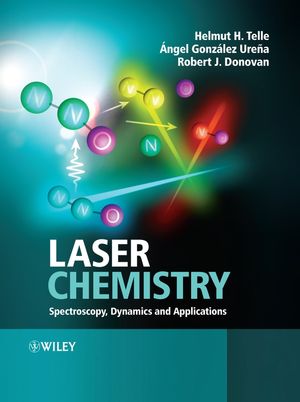Laser Chemistry: Spectroscopy, Dynamics and ApplicationsISBN: 978-0-471-48571-1
Paperback
520 pages
May 2007
 This is a Print-on-Demand title. It will be printed specifically to fill your order. Please allow an additional 10-15 days delivery time. The book is not returnable.
Other Available Formats: Hardcover
|
||||||
Angel Gonzalez Urena obtained a chemistry degree from the University of Granada (Spain) in 1968, followed by a PhD in Physical Chemistry from the Complutense University (Madrid, Spain) in 1972. During the period 1972-1974 he worked in the fields of molecular beam and reaction dynamics at the Universities of Madison (Wisconsin, USA) and Austin (Texas, USA), and in later years at universities in the UK. He became Associate Professor in Chemical Physics in 1974 and Full Professor in 1983, both at the Completeness University of Madrid. His research interests focus mainly on gas-phase, cluster and surface reaction dynamics, using molecular beam and laser techniques. He was one of the pioneers in measuring threshold energies in chemical reactivity when changing the translational and electronic energy of the reactants, as well as in the measurements of high-resolution spectroscopy in intra-cluster reactions. More recently, his interests have branched out into the application of laser technologies to Analytical Chemistry, Environmental Chemistry, Biology and Food Science. he is the head of the Department of Molecular Beams and Lasers at the Institution Pluridisciplinar (Complutense University, Madrid); for the first 10 years of the institute's existence he also was its first director. He has held visiting appointments at Cambridge University (UK), at the universite de Paris Sud (France) and at the Academia Sinica, Taiwan National University (Taipei, Taiwan).
Robert J. Donovan Graduated (BSc Hons) from the University of Wales in 1962. Following a year in industry, with Procter and Gamble appointed a Research Fellow of Gonville and Caius College (Cambridge) in 1966, and in 1970 he moved to the Department of Chemsitry at the University of Edinburgh. In 1979 he was appointed Professor of Physical Chemistry, and in 1986 he was appointed to the Foundation (1713) Chair of Chemistry at Edinburgh. His research interests lie in the fields of gas-phase energy transfer, photochemistry, reaction dynamics, spectroscopy and atmospheric chemistry. He was one of the pioneers of kinetic spectroscopy in the vacuum ultraviolet and has contributed substantially to the use of lasers and synchrotron radiation for the study of chemical and physical processes involving electronically excited states. His work in the field of spectroscopy has involved extensive studies of Rydberg, ionic and charge-transfer states, using optical-optical double resonance (OODR), resonance-enhanced multiphoto ionization (REMPI) and zero kinetic energy (ZEKE) photoelectron spectroscopy. In addition, he has applied laser techniques to a number of analytical areas, including LIBS, matrix-assisted laser desorption and ionization (MALDI) and aerosol mass spectrometry (AMS). He has held visiting appointments at the Universities of Alberta (Canada), Gottingen (Germany), Canterbury (New Zealand), the Australian National University at Canberra, the Tokyo Institute of Technology and the Institute for Molecular Science (Okazaki, Japan).



